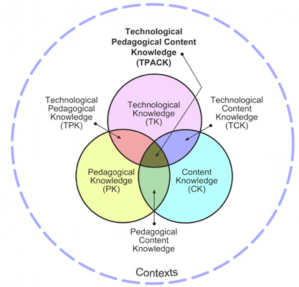Looking Back
TPACK-The Total PACKage
The first thing that comes to my mind when I am reflecting on what I have learned this summer is TPACK. It seems to be the predominant force behind all of the other teachings. The interaction between Content Knowledge, Pedagogical knowledge, and Technological knowledge are key aspects in being an effective teacher. My educational goal is to make sure each of the three areas combine to form Technological Pedagogical Content Knowledge (TPACK). In order to make this happen, I have to make sure that I have a strong understanding in each of these three areas. Throughout this course, we have been supplied with information and resources to make sure we have the skills to “uncover” content and enrich are students with knowledge.
I am going to address how throughout the class we were supplied with resources to enhance are teaching skills in each of these three areas: Content Knowledge, Pedagogical Knowledge, Technological Knowledge.
Content Knowledge
“Thus, given the changing world we live in, it becomes critical for us to ask ourselves what it is that today’s students need to know to succeed (Mishra, Koehler, Henricksen, The trans-disciplinary habits of the mind: Extending the TPACK framework towards 21st Century Learning (4).”
I have learned that Personal Learning Networks (PLNs) are a great way for educators to continually enrich and update their Content Knowledge information. Teachers can keep up on new educational theories, technologies, materials, trends and lessons by reading blogs, wikis, and watching videos on You Tube. They can organize all of their information using RSS Feeders(netvibes, pageflakes, igoogle) or social bookmarking sites(delicious or diigo). By using these tools, teachers receive only the information that pertains to them and are notified when new information is put on a site. This cuts back on the time it used to take to search for each site daily. Teachers can also share and collect websites that others have found contain good information. The next tool I learned that helps keep educators content area strong is social networking.
By joining online groups that share common educational or subject specific interests allow teachers to create a social network. In class, I learned a social network can be used to find out about Professional development opportunities or tutorials that may be available online. Teachers can connect with other educators and experts across the world via twitter, skype, or facebook. They can collaborate on projects, seek or give advice, or observe different teachers in action.
Professional Development also plays a key role in having strong Content Knowledge information. There are many free resources available online. Teachers can seek information or tutorials by searching the Internet or using their PLNs to ask for good Professional Development sites in certain areas.
I will continue to use my PLN to communicate with colleges and continuously seek professional development to make sure I have the Content Knowledge to teach students what they need to be successful in today’s society.
Pedagogical Knowledge
I have learned many different teaching strategies that teachers can use. Whether a teacher is using collaboration, constructivism, inquiry, project based, didactic or cooperative, I have been taught that it is important that they chose the best method for the content and application they are using. I agree with the TPACK method, that our Pedagogy should change with the times, the technology and the content(Mishra, Koehler, Henricksen, The trans-disciplinary habits of the mind: Extending the TPACK framework towards 21st Century Learning 4). It is most important that we touch on several different learning styles through our teaching methods, and vary or teaching strategies within each lesson.
According to Jere Brophy (1987)”…motivation to learn is a competence acquired through general experience but stimulated most directly through modeling, communication of expectations, and direct instruction or socialization by significant others (especially parents and teacher).” When creating lesson plans I always spend a lot of time pondering whether my students will be motivated to accomplish the project. After reading the article by Linda Lumsden, Student Motivation to Learn, I believe that with incorporating modeling, clear expectations, ample practice exercises, scaffolding and direct instructions students will be motivated to accomplish most projects given to them. I believe that if students are provided with enough information and resources to refer back to, it will take away the fear of failing for many students.
Technological Knowledge
This class has taught me the key word to using technology in the classroom is, “repurposing.” I am now aware that knowing how different technologies work is not enough. As an educator, I need to be able to explore the different technologies to come up with an educational use that will enhance the content I am teaching. My job is to “uncover” content with technology, while using the technology tool to increasing the students’ ability to learn.
This class has opened my eyes to a new way of teaching. I feel energized and ready to begin a new school year. My tool belt is overflowing and I cannot wait to use my new found resources to create an even better learning experience for my students. The collaboration and enriching conversations that happened were refreshing. I am now on a new mission to create, explore, and share!
Resources:
Mirshra, Punya, Matthew Koehler, and Danah Henricksen. "The 7 Trans-Disciplinary Habit of Mind:Extending the TPACk Framework Towards 21st Century Learning."(2010)Print.
Wiggin, Grant, Jay McTighe. "Understanding Understanding" Association for Supervision and Curriculum Development(2005):1-18. Wed. 18 June 2010.

